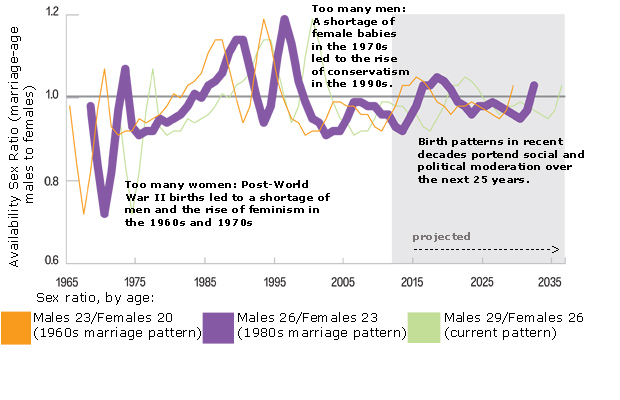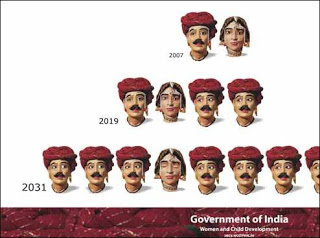Marcia Guttentag was a social psychologist at Harvard University who proposed in her book, Too Many Women?, that sex ratios among people at a marrying age determined whether a society has conservative or socially progressive values. She argued that the number of men versus women had profound impact on social and sexual attitudes, values, economics and politics, and that it correlated with the number who remained single versus married.
In her book she stated that sex ratios impact the distribution of wealth, alter who sits in board rooms and at the executive levels of corporations, and what governments do over time.
Today the global ratio of male to female births is 1.07:1. That is for every 107 males born, 100 females are born. This ratio is fairly close to historical averages and may reflect the higher incidence of male mortality when compared to female during youth and adolescence.
Guttentag studied birth patterns in formulating her theory. She argued that liberalism in the 1960s in the United States was directly correlated to an excess number of females to males born during the war years reaching marriageable age. Guttentag passed away in 1977. But she would have argued that higher male to female birth ratios in the U.S. in the late 1970s and early 80s reaching marriageable ages by the early 2000s was equally responsible for the conservative ideology of the George W. Bush presidency.
The diagram below plots the sex ratio of marriage-aged males and females over time. Note how ratios of male to female births and the allowance for age separation of three years between the two sexes at the time of marriage, align with social outlook changes within roughly 25 year cycles.
 Does this theory hold true for societies other than the United States? In the Soviet Union of the 1940s the male to female population was deeply affected by war deaths. The result was an aggressive Soviet policy to support the proliferation of unmarried and widowed single mothers after the war. Similarly the drop in male to female ratios in the Japanese population during the Second World War led to subsidies for unmarried pregnant women and laws that freed men from being responsible for their illegitimate children with the state stepping in to act as surrogate.
Does this theory hold true for societies other than the United States? In the Soviet Union of the 1940s the male to female population was deeply affected by war deaths. The result was an aggressive Soviet policy to support the proliferation of unmarried and widowed single mothers after the war. Similarly the drop in male to female ratios in the Japanese population during the Second World War led to subsidies for unmarried pregnant women and laws that freed men from being responsible for their illegitimate children with the state stepping in to act as surrogate.
China today has enforced a one child policy. With males preferred and females aborted, China has a heavily skewed male to female sex ratio that is now impacting social progress within the country. The continuation of conservative social policy may be a direct result of sex ratio determinism. India doesn’t enforce a one child policy but social convention is inhibiting female births resulting in an increasingly skewed male to female ratio as shown in the forecast below. This may be one explanation for the high levels of female sexual abuse that currently plagues the country.
In the January 15 edition of the New York Times an article, entitled In North Dakota: An Abundance of Oil, a Shortage of Women describes the impact high male to female sex ratios have had on three counties in the state and the scary situation in which women are finding themselves because of this. This type of sex ratio skewing is unrelated to birth rate and can be seen happening in other parts of the world largely driven by economics. For example, Qatar has a high male to female sex ratio because it imports thousands of men to work on its liquid natural gas projects. While Djibouti, near Somalia, has the reverse with unemployment so high that 40-50% of its male population emigrate to find work.
When Guttentag wrote Too Many Women? she would not have anticipated the impact of technology on the generation of Millennials who today are leaving home later and remaining single much longer. Today the male to female sex ratio in the U.S. is 1:1.03. What will remaining single longer with higher female sex ratios lead to, a feminist agenda focused on family and women’s issues, or social behaviour that is entirely different? We shall see if her hypothesis continues to ring true in these next few decades.









